Introduction
The tree tomato (Solanum betaceum) is one of the most important members of the Solanaceae family and the genus Solanum cultivated in South America. The tree tomato is native to tropical and subtropical climates, is found from Colombia to Peru (Albornoz, 1992), and grows between 1600 and 2400 m a.s.l. It is a semi-shade and perennial plant species that can grow to between 3.0 m and 5.5 m in height. Plant development from seeds to fruiting occurs after 18 months, and its commercial life takes seven to eight years. The flowers are pink and lavender and are grouped in terminal clusters that bloom in stages between May and June (Ramírez and Kallarackal, 2019). The fruits are berries whose colors vary from yellow to red, are ovoid with pointed apices and contain approximately 150-300 small seeds (Vasco et al., 2009).
Although it is a lesser known species, the tree tomato has great economic potential thanks to its fruits or some ornamental species. However, the development of technologies for seedling production is necessary to reach full potential. Dormancy in freshly extracted seeds is thought to reduce the germination of tree tomato seeds. Tree tomato propagation is mainly by seed (Neto et al., 2015), and seedling emergence of tree tomato seeds is low and uneven, deterring the formation of quality seedlings. Dormancy is also a problem directly related to germination and storage of tree tomato seeds (Neto et al., 2015).
Allelopathy is defined as the effects of a plant or organism on another through the emission of chemicals with stimulating or inhibitory effects (Rice, 1979). Allelopathy more commonly refers to the inhibitory effects of one species on another. All of the allelochemicals present may not always be harmful, as beneficial interactions have also been reported (Mavi, 2014). Allelochemicals that inhibit the growth of some species at certain concentrations can stimulate the growth of the same or of different species at lower concentrations.
Bioherbicides are used as an alternative to the intensive use of synthetic herbicides that cause serious environmental hazards and increase production costs (Atak et al., 2016). Bioherbicides have also found use as antifungal, antimicrobial and antibacterial coating material in fruit storage (Kotan et al., 2013). However, studies on their positive effects on germination, emergence and seedling development are limited. Hence, positive effects of these natural herbicides on seedling development and quality should be studied in different fields, particularly organic farming. Fungal infections during seed germination are one of the important factors preventing seedling development from seeds. The antifungal properties of such allelochemicals can be useful for the development of healthy and quality seedlings (Mavi, 2018).
Moringa oleifera leaf extract is the most studied allelopathic species for stimulation of germination and emergence (Basra et al., 2011). The allelopathic effect of marigold extract as an organic material in priming applications has been used successfully in seed applications in ornamental plants (Mavi, 2013), eggplant (Mavi, 2014), watermelon (Mavi and Atak, 2016), mulberry (Gündüz et al., 2019) and different pepper species (Mavi, 2016; Mavi, 2018). Different species of wild fennel (Turkyilmaz-Unal et al., 2019) and lantana (Achhireddy and Singh, 1984) are also known as allelopathic species, and their stimulatory effects have not been studied. Whereas in previous research the leaves and roots of plants were used to assess the negative allelopathic effect of these genera, this experiment was designed to determine the stimulatory effect of the gum of ferula (Ferula elaeochytris Korovin) and petals of lantana (Lantana camara L.). These two species, along with the marigold (Tagetes patula L.) whose allelopathic effect on different species was known, were used to study their effect on the seedling emergence and performance of the tree tomato.
Materials and methods
Seeds taken from the mature fruits of a tree tomato genotype found in the genetic collection of exotic vegetables belonging to the Faculty of Agriculture, Department of Horticulture at Mustafa Kemal University in Turkey were used in this research.
Marigold flowers were collected, and the petals were extracted from the flowers and dried for 10 d in the shade at room temperature (25±3°C). The dried petals were stored in glass jars in the laboratory until the treatment was carried out. The dried petals (4 g) were brewed in boiling distilled water (1 L) and after cooling, this herbal tea was used as an allelopathic priming material. Application of marigold is referred to in this paper as TAG.
Lantana flowers were collected, and petals of the flower were dried; the extracts (4 g L-1 dried petal) were prepared in a similar manner as that of marigold. Lantana treatment is termed LAN in this paper.
Wild fennel is a species used for medicinal purposes with roots locally known as Çakçir (Hatay -Turkey) or hinojo in Spanish. This species is collected by removing the roots. In the observations we made, pure sap flowed from the regions close to the roots of the species, and the sap became amber-colored when it dried (Fig. 1A-B). The use of this wild fennel gum, instead of removing the plant completely, prevents damage to natural flora. Determining the stimulatory effect of this wild fennel gum on germination and emergence is important for organic farming. The gum was dissolved in boiling water (0.2 g gum L-1) and was used for seed treatment after cooled. This dose was determined after preliminary studies (data not shown). Wild fennel gum treatment is called FER in this article.
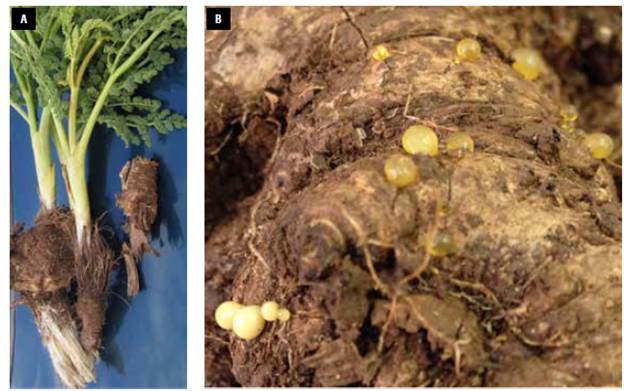
FIGURE 1 A) General view of a wild fennel (Ferula elaeochytris) plant; B) Pure sap flowing from the root that turns amber when dried.
The seeds of the tree tomato were treated on filter paper moistened with 30 ml of each treatment and kept in 15 cm petri dishes in the dark at 25°C for 72 h. Seeds were covered with plastic film during the priming treatment to ensure that there was no loss of moisture. Once the treatment was completed, the seeds were rinsed with tap water. All conditions (temperature, duration, etc.) were the same for all treatments. All treated seeds were used in emergence tests after surface drying. Untreated dry seeds were kept as controls (CON).
After the treatments, emergence tests were conducted after seeds were surface-dried and three replicates of 25 seeds per treatment were set up. To determine the effects of pre-sowing treatments on seedling emergence, seeds were sown at a depth of 1 cm in plastic boxes with peat moss (pH 5.5-6.5, electrical conductivity 40 mS m-1, Potgrond P, Klasman, Germany). Seedlings were grown under laboratory conditions at 23±2°C for 24 d. The appearance of the hypocotyl hook on the peat moss surface was used as an emergence criterion and emerged seedlings were recorded daily. To measure the effect of the pre-sowing treatments on emergence uniformity, the emergence percentage, mean emergence time (Orchard, 1977), emergence index (Maguire, 1962), and coefficient of velocity of emergence (Kader, 2005) were calculated.
Following the stabilization of the number of emerged seedlings, 21 normally developed seedlings of each treatment were randomly harvested to determine the seedling growth rate. The length (cm) and fresh and subsequently dry weights of harvested seedlings were recorded by drying at 80°C for 24 h in a laboratory oven (M3025P, Elektro-mag, Istanbul, Turkey). Fresh and dry weights were expressed as mg/plant.
The stimulatory allelopathy index (SAI) was obtained using the formula by Williamson and Richardson (1988).
where T is the treatment value and C is the control value. SAI was used to indicate the stimulatory effects of aqueous extracts on the emergence index (EI), coefficient of velocity of emergence (CVE), seedling length (SL), seedling fresh weight (SFW) and seedling dry weight (SDW).
Mean data for each character were evaluated by one-way analysis of variance (ANOVA) followed by Duncan's multiple range test. When the P value was less than 0.05 it was considered as significant. Percentages were arcsine-transformed prior to analysis and the untransformed data were shown in the figures.
Results and discussion
The percentage of cumulative emergence was determined as a significant (P≤0.05) difference between pre-sowing treatments and control seeds (Fig. 2). TAG, FER and LAN-treated seeds reached at 54%, 52% and 43%, respectively, after 10 d, while control seeds had a seedling emergence of 11% for the same time (Fig. 3). The TAG pre-sowing allelopathic treatment was superior throughout the duration of the experiment. There was little difference among all pre-sowing treatments, but a significant difference between treated and control seeds was observed. Finally, TAG-treated seeds reached 96% emergence after 18 d, while control seeds had 72% seedling emergence at that time (Fig. 2).
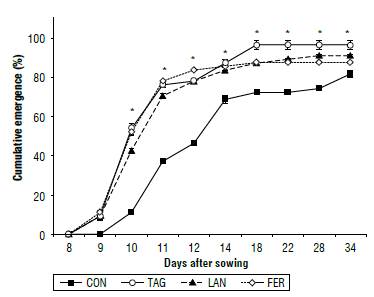
FIGURE 2 Cumulative emergence percentage of tree tomato seeds sown at 23±2°C under different extracts of allelopathic plants (TAG, LAN and FER). CON - control, TAG - marigold treatment, LAN - lantana treatment, FER - wild fennel gum treatment. Error bars represent ± standard error; n = 3. * indicates differences between untreated seeds and treatments atP<0.05.
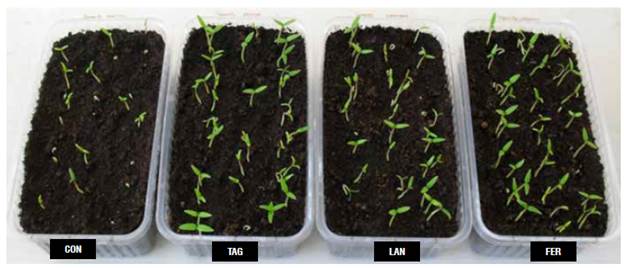
FIGURE 3 Early emerging performance of pre-sowing allelopathic treatments in tree tomato seeds 10 d after sowing. CON - control, TAG - marigold treatment, LAN - lantana treatment, FER - wild fennel gum treatment.
Mean emergence time (MET), EI, and CVE are shown in Fig. 4. The FER treatment showed a MET value of 10.55 d. No statistically significant differences were observed among MET, TAG and LAN. The MET values of these treatments were significantly higher than those obtained by the control.
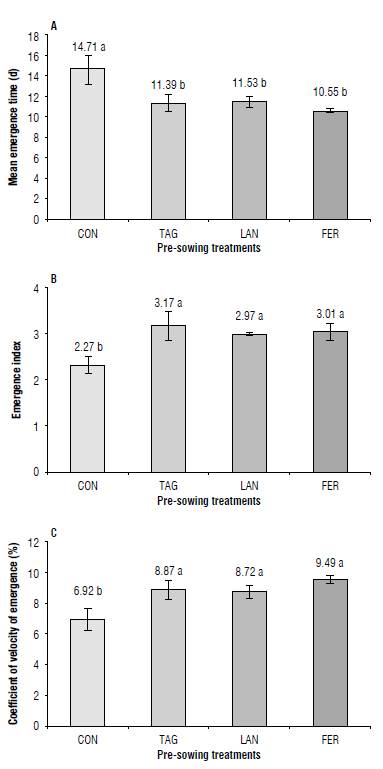
FIGURE 4 Effect of pre-sowing allelopathic treatments with TAG, LAN, and FER on A) mean emergence time, B) emergence index, and C) coefficient of velocity of emergence. CON - control, TAG - marigold treatment, LAN - lantana treatment, FER - wild fennel gum treatment. Error bars represent ± standard error; n = 3.
The EI and CVE increased with the effects of pre-sowing treatments (Fig. 4) and all of them were statistically different compared to the controls. While the highest CVE (9.49) was recorded in seeds treated with FER, the highest EI (3.17) was recorded in seeds treated with TAG.
The variables SL, SFW and SDW of plants with pre-sowing treatments with TAG, LAN and FER were better than in the untreated group (Fig. 5). Maximum SL (6.61 cm) was obtained under pre-sowing treatment with TAG, whereas the minimum SL (5.60 cm) was recorded in the seedlings from untreated seeds. Similarly, the TAG treatment showed the highest values of SFW (475 mg) and SDW (28.4 mg).
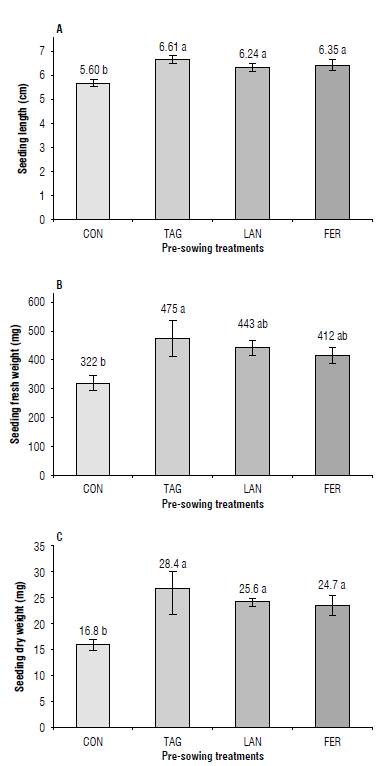
FIGURE 5 Effect of pre-sowing treatments with TAG, LAN, and FER on A) seedling length, B) seedling fresh weight, and C) seedling dry weight. CON - control, TAG - marigold treatment, LAN - lantana treatment, FER - wild fennel gum treatment. Error bars represent ± standard error; n = 3.
The five indicators, including SDW, SFW, EI, CVE and SL, were used to estimate the SAI value to know the total allelopathic intensity of the three species of pre-sowing treatment extracts on the tree tomato (Fig. 6). The SAI values of the three species of pre-sowing treatment extracts were as follows: TAG > LAN > FER.
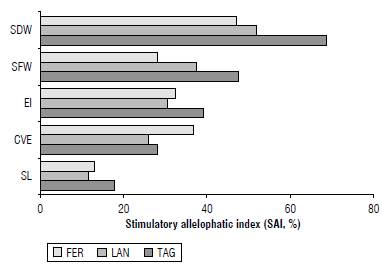
FIGURE 6 Stimulatory allelopathic index (SAI) of the three species of pre-sowing extracts of the five indicators, including seedling dry weight (SDW), seedling fresh weight (SFW), emergence index (El), coefficient of velocity of emergence (CVE) and seedling length (SL). FER - wild fennel gum treatment, LAN - lantana treatment, TAG - marigold treatment.
The results of this research highlighted the potential of allelopathic pre-sowing treatments with TAG, LAN, and FER as natural seedling growth enhancers in tree tomato.
Allelopathic materials were mostly used for weed control because of their inhibitory effects (Atak et al., 2016). However, in recent years, marigold extract (TAG) had been successfully used to improve seedling emergence and performance in some different species such as ornamental plants (Mavi, 2013), eggplant (Mavi, 2014), watermelon (Mavi and Atak, 2016), mulberry (Gunduz et al, 2019) and different types of pepper (Mavi, 2016; Mavi, 2018). In this study, it was also determined that two different allelopathic materials (LAN and FER) can be used in a tree tomato genotype to improve seedling quality.
Typically, tree tomato is propagated by seeds that have uneven germination, which may be related to dormancy (Neto et al, 2015). This characteristic is common in seeds of other Solanaceae species, such as Solanum chenopodi-oides (Cabrera et al, 2010), which have slow and irregular germination. The allelopathic pre-sowing treatments used in a tree tomato genotype caused an increase in the emergence performance (Figs. 2-4) and seedling quality (Figs. 5 and 6). A similar effect was observed in eggplant (Mavi, 2014), watermelon (Mavi and Atak, 2016) and different pepper species (Mavi, 2018) for the TAG pre-sowing treatment. The effectiveness of the allelopathic pre-sowing treatments FER and LAN has been demonstrated for the first time with this study.
Seed pre-sowing treatments (osmopriming, halopriming, hydropriming, hormonal priming, matrix priming, smoke priming, etc.) produce a repair effect at the stagnant stage before DNA synthesis. RNA, protein and DNA syntheses and some enzymes such as L-isoaspartylmethyltransferase, and catalase have caused changes in germinated seeds after priming (Come, 1983; Kester et al, 1997; Kibinza et al, 2011). In this study, the allelopathic pre-sowing treatments increased the emergence percentage, which confirms that repair mechanism.
Conclusions
In conclusion, as a result of the application of these allelopathic pre-sowing treatments, there has been a clear improvement in the emergence performance and seedling quality of tree tomato seeds. LAN (flower extract) and FER (gum extract) were used as stimulants for the first time to improve seed emergence performance in tree tomato. Although it is not possible to obtain commercially available LAN, FER and TAG extracts, the potential of these materials to be used as priming agents by a simple method has been demonstrated here. Consequently, pre-sowing treatment with allelopathic plant materials should be proposed to improve seedling emergence and performance in the tree tomato since it is an inexpensive, organic, eco-friendly, effective and simple technique. Furthermore, the allelochemicals present in these plant extracts should be studied for antibacterial effects on seedlings.















